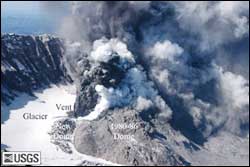Laser Technology Helps Track Changes In Mount St. Helens

Photograph taken on October 1, 2004 of renewed volcanic activity within the crater formed by the eruption of Mount St. Helens in 1980. Recent activity, concentrated on the south side of the volcanic dome formed in the 1980s, includes uplift of a new dome from beneath the crater glacier and formation of vents by glacier melting and explosive eruptions of steam and ash. Credit: USGS
U.S. Geological Survey (USGS) and NASA scientists studying Mount St. Helens are using high-tech Light Detection and Ranging (LIDAR) technology to analyze changes in the surface elevation of the crater, which began deforming in late September 2004.
With data derived from airborne LIDAR, scientists can accurately map, often in exquisite detail, the dimensions of the uplift and create better models to forecast volcanic hazards. LIDAR shows, in the two weeks before Oct. 4, the new uplift grew to the height of a 35-story building (110 meters or 360 feet) and the area of 29 football fields (130,000 square meters).
“This is the first time USGS and NASA have teamed to use LIDAR to measure volcano deformation,” said USGS scientist Ralph Haugerud. He noted LIDAR technology enables researchers to compare with greater accuracy than ever before the topography before and after volcanic events. “The resulting pictures of topographic change can reveal information found in no other kind of data set,” added David Harding, a scientist at NASA’s Goddard Space Flight Center, Greenbelt, Md.
In 2003 the USGS contracted a LIDAR survey of Mount St. Helens. In early September 2004, USGS and NASA scientists began detailed planning for a second survey. The survey, contracted by NASA, would extend the area covered by the first survey. But when the mountain began rumbling on Sept. 23, USGS and NASA scientists accelerated plans and re- surveyed the mountain on Oct. 4. The topographic changes resulting from the unrest at Mount St. Helens are shown in detail in the Oct. 4, 2004, LIDAR survey.
Some of the Mount St. Helens features related to the volcanic unrest visualized in the new LIDAR-derived Digital Elevation Model (DEM) include growth of a new volcanic dome south of the 1980-1986 volcanic dome and new steam-and-ash vents. Additional changes between the two LIDAR surveys unrelated to the volcanic unrest include shrinking snow fields, several rock falls, movement of three rock glaciers, and growth of the crater glacier, which has been an ongoing subject of USGS research at Mount St. Helens.
Comparison and analysis of the DEMs from the two surveys by Haugerud and Harding show, as of Oct. 4, 2004, 5.3 million cubic meters (6.9 million cubic yards) of volume change occurred in the area of uplift. This analysis confirms photogrammetric measurements made over the same period by the USGS.
Linda Mark, a hydrologist with the USGS Cascades Volcano Observatory, said “Global Positioning System data provide us with very accurate point measurements of deformation, but only at locations where we can place an instrument. LIDAR, however, helps us quantify the ongoing deformation in the crater of Mount St. Helens with lesser accuracy but over a much broader area. Used together, the two methods complement each other, and the LIDAR-derived DEMs can be used for modeling efforts to help forecast volcanic hazards.”
LIDAR mapping uses a scanning laser rangefinder mounted in a small aircraft to measure distances from the aircraft to the ground several tens of thousands of times each second. It commonly measures the ground position at points a meter apart with vertical accuracy as good as 10 centimeters (four inches).
NASA scientists and engineers in the 1980s and 1990s pioneered airborne LIDAR mapping, Harding said. “Because of its very high accuracy and fast turn-around of results, LIDAR is rapidly becoming the preferred method for detailed topographic mapping and is conducted worldwide on a commercial basis by numerous companies,” he said.
Media Contact
All latest news from the category: Earth Sciences
Earth Sciences (also referred to as Geosciences), which deals with basic issues surrounding our planet, plays a vital role in the area of energy and raw materials supply.
Earth Sciences comprises subjects such as geology, geography, geological informatics, paleontology, mineralogy, petrography, crystallography, geophysics, geodesy, glaciology, cartography, photogrammetry, meteorology and seismology, early-warning systems, earthquake research and polar research.
Newest articles

Parallel Paths: Understanding Malaria Resistance in Chimpanzees and Humans
The closest relatives of humans adapt genetically to habitats and infections Survival of the Fittest: Genetic Adaptations Uncovered in Chimpanzees Görlitz, 10.01.2025. Chimpanzees have genetic adaptations that help them survive…

You are What You Eat—Stanford Study Links Fiber to Anti-Cancer Gene Modulation
The Fiber Gap: A Growing Concern in American Diets Fiber is well known to be an important part of a healthy diet, yet less than 10% of Americans eat the minimum recommended…

Trust Your Gut—RNA-Protein Discovery for Better Immunity
HIRI researchers uncover control mechanisms of polysaccharide utilization in Bacteroides thetaiotaomicron. Researchers at the Helmholtz Institute for RNA-based Infection Research (HIRI) and the Julius-Maximilians-Universität (JMU) in Würzburg have identified a…



